Cherry Insect Pests
Cherry Insect Pests
Stem borer
Biology
- Eggs: White, 3–4 mm long. Usually 1 to 3 eggs are laid per niche and females may lay a total of 240 to 270 eggs. The development of larvae within the egg lasts 9 to 17 days.
- Larva: Pale yellowish, covered with golden hairs, 60–70 mm long, with black mandibles.
- Pupa: The following spring, the larvae resume feeding and construct tunnels deep into the wood. At the end of July, they prepare pupation cells protected by double plugs made from borings. Pupation occurs in these cells and about two weeks later adults appear.

- Adult: The adult of A. sarta has an elongated dark grey-brown body, 28–47 mm long, with elytra covered with short silvery hairs. Shiny silvery spots form two irregular bands crossing the elytra. The male is usually smaller than the female. The male has antennae 2.5 times as long as the body, whereas the female antennae are shorter than the body.
Damage symptoms
- Large emergence holes in trunks and large branches, and borings at the basis of infested trees, are indications of the presence of the pest. The adult beetles are conspicuous and may be seen sitting on the trunks. Branch and tree dieback is easily detected by seeing wilting and drying leaves.
Shot hole borer/pin hole borer
Biology:- Eggs: The female lays 52 eggs on an average. The eggs hatch in 5 to 7 days.
- Larva: The larvae have 5 instars and complete their development in 38 to 50 days constructing larval galleries 5-8 cm in length.
- Pupa: The larvae pupate for 6-18 days and finally the adults emerge to attack new suitable trees.
- Adults: The adults live for 45-60 days and the total life-span of this species ranges from 97 to 124 days. This common shot-hole borer overwinters in larval stage on trees. The copulation takes place at the entrance hole. The maternal gallery is one armed longitudinal, in average 4.6 cm long.
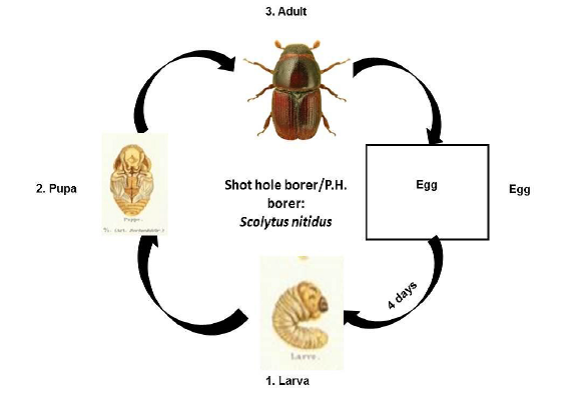
- Parasitoids: Rhaphitelus maculatus, Eurytoma morio, Eupelmus vindex, Cheiropachus quadrum, Spathius sp, Macromesus harithus, Heydenia indica, Eupelmus vindex, Eupelmus kashmiricus and Eupelmus valsus
- Predators: Monomorium minutum , Tetramorium christiei, Polemistus sp., big-eyed bug, earwig, ground beetle, pentatomid bug.
- Entomopathognic fungi: Aspergillus versicolor, Penicillium aurantiogriseum and Geosmithia putterillii
Pear psylla
Biology- Egg: Eggs are minute, oval, and creamy white to yellow. Eggs laid before buds open in spring, and through early fall, eggs are deposited in lines or rows on the terminals and fruit spurs after buds open, eggs are deposited along mid-veins and petioles of developing leaves and on stems and sepals of blossoms. Eggs are hatch when foliage appears and continues throughout growing season.
- Nymph: Early instars are about 1.6 mm long and light yellow; later instars are dark green to dark brown with wing pads and two conspicuous red eyes. Nymphs are cylindrical, but appear flattened and found on the undersides of leaves. Pass through five instars, which are generally covered by a drop of honeydew. Moves little at first but later instars move easily. Feeds and develops on new growth and water sprouts. Produces honeydew.
- Adult: Adults are 4 mm long and red-brown to black; larger and darker than summer adults. It resembles miniature cicada with wings held roof-like over the abdomen. Hides under bark, under litter on the orchard floor, or in sites outside the orchard. Adults leave the pear trees in Oct.-Nov. for wintering sites and return about 6 weeks before bloom. Feed by sucking juice from the host tree. Begin laying eggs after buds begin to swell.
Life cycle
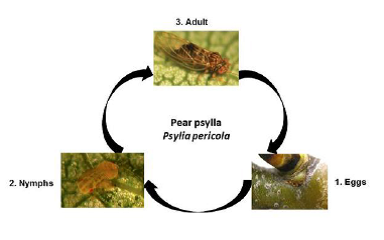
Damage symptoms
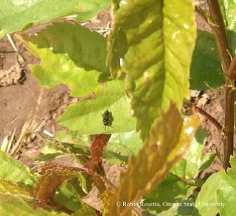 Nymphs and adults suck sap primarily from the tender foliage of the new shoots and water sprouts. Feeding by nymphs produces a large amount of honeydew, which makes the tree sticky and promotes the growth of sooty mold (black fungus). The honeydew can run onto fruit causing dark russet blotches or streaks resulting in unmarketable fruit.
Nymphs and adults suck sap primarily from the tender foliage of the new shoots and water sprouts. Feeding by nymphs produces a large amount of honeydew, which makes the tree sticky and promotes the growth of sooty mold (black fungus). The honeydew can run onto fruit causing dark russet blotches or streaks resulting in unmarketable fruit.
Natural enemies of psylla
Predators: Lacewings, ladybird beetles, minute pirated bugs, predatory mites, anthocorid bugs, spiders
Green peach aphid
Biology- Egg: Eggs are deposited on Prunus spp. trees. The eggs measure about 0.6 mm long and 0.3 mm wide, and are elliptical in shape. Eggs initially are yellow or green, but soon turn black. Mortality in the egg stage sometimes is quite high.
- Nymph: Nymphs initially are greenish, but soon turn yellowish, greatly resembling viviparous (parthenogenetic, nymph-producing) adults. They are of four instars, with the duration of each averaging 2.0, 2.1, 2.3, and 2.0 days, respectively. Females gave birth to offspring six to 17 days after birth, with an average age of 10.8 days at first birth. The average length of life was about 23 days, but this was under caged conditions where predators were excluded. The daily rate of reproduction averaged 1.6 nymphs per female. The maximum number of generations observed annually during these studies was determined to be 20 to 21, depending on the year.
- Adult: Up to 8 generations may occur on Prunus in the spring, but as aphid densities increase winged forms are produced, which then disperse to summer hosts. Winged (alate) aphids have a black head and thorax, and a yellowish green abdomen with a large dark patch dorsally. Theymeasure 1.8 to 2.1 mm in length. Winged green peach aphids seemingly attempt to colonize nearly all plants available. They often deposit a few young and then again take flight. This highly dispersive nature contributes significantly to their effectiveness as vectors of plant viruses.
Life cycle
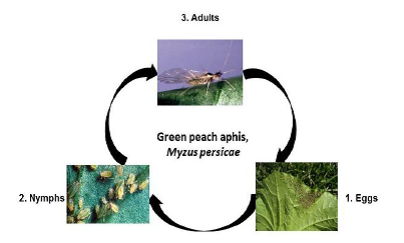
Damage symtpoms
- Most species of plant feeding thrips, have piercing and rasping mouthparts.
- The surface of the leaf develops a crinkled silvery appearance as a result of damage to cells below the surface.
- Lightly-infested plants show silvery feeding scars on the under surface of leaves, especially alongside the mid rib and veins.
- Heavily-infested plants show silvering and browning of leaves, stunting of young leaves and terminal growth, with fruit scarred and deformed.
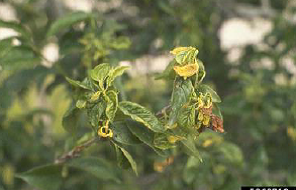
- Developing leaves become distorted in the growing tips.
Natural enemies of thrips
- Parasitoids: Thripobius semiluteus
- Predators: Predatory mite, predatory thrips, hover fly, mirid bug, Oligota spp., Orius spp etc.
Thrips
Biology:
- Egg: The eggs are deposited within plant tissues singly.
- Larva and pupa: Larvae have two stages, which feed on plant tissues. The second instar larvae, when mature, fall to ground, where they molt to prepupae and pupae in the soil.
- Adult: After emergence, the adults move to the growing parts of the plants such as young leaves, flowers, or young fruits, where they feed and lay eggs (about 200 eggs per female). Adults are usually found on young leaves, while larvae are found on lower or older leaves. A 25°C, the life cycle is completed in approximately 17 days. Adults are winged sucking rasping insects ranging from 5-14 mm in length. Their slender bodies are shiny pale or black with silver stripes Life cycle completed in 11-43 days. Produce many generations in a year heaviest damage occur in spring. In colder region, life cycle is longer with fewer generations.
Life cycle:
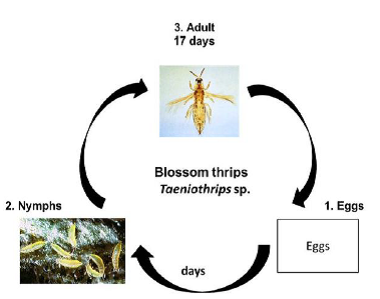
Damage symptoms:
- Most species of plant feeding thrips, have piercing and rasping mouthparts.
- The surface of the leaf develops a crinkled silvery appearance as a result of damage to cells below the surface.
- Lightly-infested plants show silvery feeding scars on the under surface of leaves, especially alongside the mid rib and veins.
- Heavily-infested plants show silvering and browning of leaves, stunting of young leaves and terminal growth, with fruit scarred and deformed.
- Developing leaves become distorted in the growing tips
Natural enemies of thrips:
- Parasitoids: Thripobius semiluteus
- Predators: Predatory mite, predatory thrips, hover fly, mirid bug, Oligota spp., Orius spp etc.
IPM for Cherry
To know the IPM practices for Cherry, click here.
Source: NIPHM; Directorate of Plant Protection, Quarantine & Storage
Last Modified : 3/23/2020
© C–DAC.All content appearing on the vikaspedia portal is through collaborative effort of vikaspedia and its partners.We encourage you to use and share the content in a respectful and fair manner. Please leave all source links intact and adhere to applicable copyright and intellectual property guidelines and laws.
RELATED ITEMS
Cherry Pests
This topic provides information about Cherry Pests...
Cherry Beneficial insects
This topic provides information about Cherry: Bene...
Pear Insect Pests
This topic provides information about Pear- Insec...
Cherry Diseases
This topic provides information about Cherry: Dise...
